Tire Pressure Monitoring Systems (TPMS) are essential for maintaining optimal tire pressure and ensuring vehicle safety. However, installing a TPMS can be tricky, especially for first-timers. ReadyTech offers solutions that simplify the process, making installation smooth and hassle-free. To help you get the most out of your TPMS, we’ve compiled the top 10 tips for seamless installation with ReadyTech. Follow these tips for a smooth, efficient, and error-free experience.
1. Choose the Right TPMS Sensors for Your Vehicle
Not all TPMS sensors are universal. Different vehicles require different sensors. Before installation, make sure you have the correct sensors compatible with your vehicle’s make, model, and year. ReadyTech offers a comprehensive database to help you choose the right sensor for your specific vehicle. By selecting the proper sensor, you avoid compatibility issues and installation errors.
Pro Tip: Always double-check the part number and cross-reference with the manufacturer’s specifications to ensure compatibility.
2. Use ReadyTech’s Diagnostic Tools for Pre-Installation Checks
Before you begin the installation process, use ReadyTech’s diagnostic tools to assess your vehicle’s current TPMS system. These tools can identify any pre-existing issues or malfunctions in the sensors or control units. Fixing these issues before installing new TPMS sensors ensures a smoother process and prevents unexpected complications later.
Pro Tip: Scan your vehicle’s TPMS system to clear old error codes and ensure the system is functioning correctly.
3. Ensure Proper Sensor Activation
TPMS sensors need to be activated before they can start sending data to the vehicle’s control unit. Some sensors are pre-activated, while others require manual activation using a TPMS tool. ReadyTech provides tools that simplify the activation process, making it easy to sync new sensors with your vehicle’s system.
Pro Tip: Use ReadyTech’s TPMS programming tool to quickly activate and pair your sensors without complications.
4. Check Tire Pressure Before Installation
Tire pressure plays a crucial role in the performance of your TPMS. Before installing new sensors, ensure your tires are properly inflated to the manufacturer’s recommended levels. Incorrect tire pressure can trigger false alerts from the TPMS, leading to confusion and unnecessary troubleshooting.
Pro Tip: Use a high-quality tire pressure gauge to check and adjust your tire pressure to the correct level before sensor installation.
5. Avoid Sensor Damage During Installation
TPMS sensors are delicate and can be easily damaged if not handled properly. To avoid damaging the sensors, follow the manufacturer’s guidelines during installation, and use the correct tools. ReadyTech provides sensor-specific installation guides and tools that minimize the risk of damage, ensuring the sensors remain intact and fully functional.
Pro Tip: Avoid using excessive force or improper tools when mounting the TPMS sensors. Always follow the recommended torque settings.
6. Replace TPMS Valve Stems if Necessary
Valve stems can wear out over time, and using old, damaged stems can lead to leaks and sensor malfunctions. If your valve stems are worn or damaged, replace them during the TPMS installation process. ReadyTech offers high-quality valve stems compatible with various TPMS sensors, ensuring a secure and reliable installation.
Pro Tip: Inspect your valve stems during the installation process. Replace any that show signs of cracking or wear to avoid future issues.
7. Calibrate Sensors Using ReadyTech Tools
After installing the sensors, they must be calibrated to ensure accurate data transmission. Calibration allows the TPMS sensors to sync with the vehicle’s control unit, ensuring they provide accurate tire pressure readings. ReadyTech’s calibration tools make this process quick and efficient, ensuring your sensors are properly aligned with your vehicle’s system.
Pro Tip: Always calibrate new sensors immediately after installation to avoid inaccurate readings or system malfunctions.
8. Update Your Vehicle’s TPMS System
In some cases, your vehicle’s TPMS system may require software updates to support new sensors. Check with the manufacturer or ReadyTech’s support resources to determine if an update is necessary. Keeping your vehicle’s software up-to-date ensures the TPMS sensors communicate effectively with the system, preventing errors or misreading’s.
Pro Tip: Use ReadyTech’s diagnostic tool to check if your vehicle’s TPMS system requires updates. Always perform necessary updates before installation.
9. Test Sensors After Installation
Once you’ve installed and calibrated the sensors, it’s essential to test the entire system. Take your vehicle for a test drive to ensure the TPMS is working correctly. ReadyTech offers testing tools that can simulate tire pressure changes and validate sensor performance. This step ensures that your new sensors are functioning as expected and providing accurate tire pressure data.
Pro Tip: Test each sensor individually by reducing tire pressure and checking for alerts on the vehicle’s dashboard.
10. Maintain Regular Sensor Inspections
After installing your TPMS sensors, regular maintenance is crucial for optimal performance. Periodically inspect the sensors and valve stems for wear and tear. Also, keep an eye on your tire pressure to ensure your TPMS is providing accurate readings. ReadyTech’s TPMS monitoring tools can help you stay on top of sensor performance, preventing issues before they arise.
Pro Tip: Schedule a biannual inspection of your TPMS sensors to ensure they remain in good working condition and replace any damaged components as needed.
Bonus Tips for Successful TPMS Installation with ReadyTech
Here are a few extra tips to ensure your TPMS installation is seamless and stress-free:
- Follow Manufacturer Instructions: Always read and follow the installation instructions provided by both the sensor manufacturer and ReadyTech. This ensures proper installation and prevents any issues that might arise from incorrect handling.
- Keep Your Work Area Clean: Install TPMS sensors in a clean, dust-free environment to avoid contamination that could interfere with sensor performance.
- Store Spare Sensors Safely: If you purchase extra TPMS sensors, store them in a cool, dry place away from extreme temperatures and humidity. This preserves their integrity until you need them.
Common Mistakes to Avoid
- Skipping Pre-Installation Diagnostics: Failing to run a diagnostic check before installing new TPMS sensors can lead to misdiagnosed issues and wasted time.
- Using Incorrect Tools: Using improper tools during installation can damage sensors, causing them to malfunction. ReadyTech provides compatible tools designed for seamless installation.
- Overtightening Sensors: Overtightening TPMS sensors can damage the delicate components inside. Always follow torque specifications for each sensor.
- Ignoring Software Updates: Outdated software can prevent new sensors from functioning correctly. Always check for updates before installation.
- Skipping Post-Installation Testing: Failing to test sensors after installation can lead to issues later on. Always test the system before hitting the road.
Why Choose ReadyTech for TPMS Installation?
ReadyTech is a trusted name in TPMS technology, offering top-quality sensors, tools, and installation support. Their products are designed to simplify the installation process, making it easy for both professionals and DIY enthusiasts to install and maintain TPMS systems. Here’s why ReadyTech stands out:
- Comprehensive Support: ReadyTech offers extensive guides, diagnostic tools, and customer support to assist you during the installation process.
- High-Quality Sensors: ReadyTech’s sensors are reliable, durable, and compatible with a wide range of vehicle models.
- Innovative Tools: ReadyTech provides specialized TPMS tools that make installation, activation, and calibration easier than ever.
- Affordable Solutions: ReadyTech’s products offer excellent value for money, providing high-quality solutions at competitive prices.
- User-Friendly Interfaces: ReadyTech’s tools are designed with user experience in mind, making them accessible for both professionals and everyday drivers.
Conclusion
Installing TPMS sensors can seem challenging, but with the right tools and techniques, it becomes a straightforward process. By following these top 10 TPMS tips for seamless installation with ReadyTech, you can avoid common pitfalls, ensure accurate sensor performance, and maintain the safety of your vehicle. From choosing the right sensors to calibrating and testing them, ReadyTech offers everything you need for a hassle-free installation.
Whether you’re a seasoned professional or a first-time installer, these tips will help you achieve seamless results and keep your TPMS functioning at its best.

